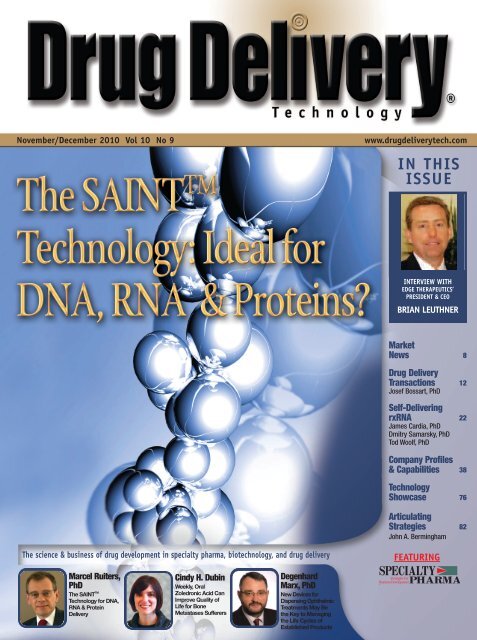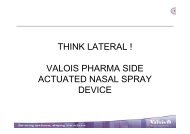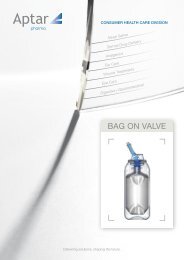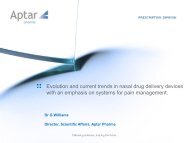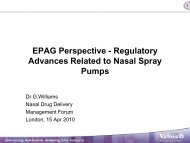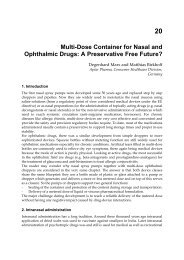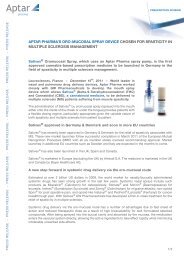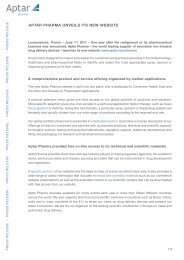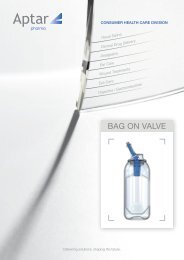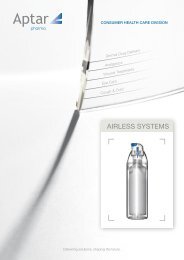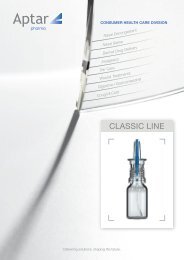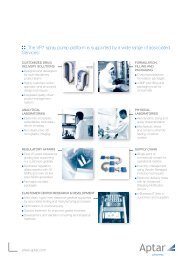Download the article - Aptar
Download the article - Aptar
Download the article - Aptar
Create successful ePaper yourself
Turn your PDF publications into a flip-book with our unique Google optimized e-Paper software.
November/December 2010 Vol 10 No 9 www.drugdeliverytech.com<br />
IN THIS<br />
ISSUE<br />
Market<br />
News 8<br />
Drug Delivery<br />
Transactions 12<br />
Josef Bossart, PhD<br />
Self-Delivering<br />
rxRNA 22<br />
James Cardia, PhD<br />
Dmitry Samarsky, PhD<br />
Tod Woolf, PhD<br />
Company Profiles<br />
& Capabilities 38<br />
Technology<br />
Showcase 76<br />
Articulating<br />
Strategies 82<br />
John A. Bermingham<br />
The science & business of drug development in specialty pharma, biotechnology, and drug delivery FEATURING<br />
Marcel Ruiters,<br />
PhD<br />
The SAINT TM<br />
Technology for DNA,<br />
RNA & Protein<br />
Delivery<br />
Cindy H. Dubin<br />
Weekly, Oral<br />
Zoledronic Acid Can<br />
Improve Quality of<br />
Life for Bone<br />
Metastases Sufferers<br />
Degenhard<br />
Marx, PhD<br />
New Devices for<br />
Dispensing Ophthalmic<br />
Treatments May Be<br />
<strong>the</strong> Key to Managing<br />
<strong>the</strong> Life Cycles of<br />
Established Products<br />
INTERVIEW WITH<br />
EDGE THERAPEUTICS’<br />
PRESIDENT & CEO<br />
BRIAN LEUTHNER
Drug Delivery Technology November/December 2010 Vol 10 No 9<br />
16<br />
New Devices for Dispensing Ophthalmic Treatments May Be<br />
<strong>the</strong> Key to Managing <strong>the</strong> Life Cycles of Established Products<br />
By: Matthias Birkhoff and Degenhard Marx, PhD<br />
According to <strong>the</strong> World Health<br />
Organization (WHO), about 314<br />
million people worldwide suffer<br />
from impaired vision; 45 million of <strong>the</strong>m<br />
are blind. About 82% of all individuals who<br />
are visually impaired are aged 50 or older,<br />
representing 19% of <strong>the</strong> world’s population.<br />
An increasing number of people are at risk<br />
of age-related visual impairment as <strong>the</strong><br />
global population grows and demographics<br />
shift to a higher proportion of older people,<br />
even in developing countries. 1<br />
These figures do not include people<br />
suffering from transient infections, dry eye<br />
syndrome, or allergic conjunctivitis. Based<br />
on <strong>the</strong>se facts, it may be concluded that <strong>the</strong><br />
majority of ophthalmic medication is and<br />
will be for chronic treatment, with a special<br />
focus on older people.<br />
For chronic treatment, multidose<br />
containers are most useful and very cost<br />
effective. For ophthalmic use, few<br />
alternatives are available, and most current<br />
packaging concepts require preservatives in<br />
<strong>the</strong> formulation to warrant microbial<br />
stability. The following discussion will<br />
describe a targeted approach for <strong>the</strong><br />
development of new preservative-free<br />
multidose devices for ophthalmic<br />
medications.<br />
MATCHING PATIENT<br />
EXPECTATIONS WITH<br />
PHARMACEUTICAL<br />
REQUIREMENTS<br />
New devices need acceptance from<br />
patients and consumers to become<br />
successful on <strong>the</strong> market. To access <strong>the</strong><br />
opinion of patients, people from different<br />
areas of <strong>the</strong> world were asked to evaluate a<br />
range of different available devices as well<br />
as a few new concepts.<br />
Though <strong>the</strong> interviewed population<br />
was comparably small, <strong>the</strong> users considered<br />
easy and intuitive handling of <strong>the</strong><br />
packaging much more important than any<br />
o<strong>the</strong>r aspect. For at least one-fifth of people<br />
in <strong>the</strong> study, <strong>the</strong> presence of preservatives<br />
in <strong>the</strong> formulation was an issue. Any<br />
actuation in <strong>the</strong> direction toward <strong>the</strong> eye<br />
was totally unacceptable, and any spacer or<br />
distance holder was also judged to be<br />
unacceptable. Drops were much preferred<br />
to sprays. From this survey, it was<br />
concluded that a preservative-free squeeze<br />
dropper or side-actuated dropper would be<br />
most appreciated by patients.<br />
Equally important stakeholders in <strong>the</strong><br />
field are, of course, <strong>the</strong> manufacturers of<br />
ophthalmic medications. Important<br />
requirements here are compatibility of <strong>the</strong><br />
packaging material with <strong>the</strong> pharmaceutical<br />
formulation and <strong>the</strong> manufacturing and<br />
filling processes. Production and filling of<br />
ophthalmic medications are highly<br />
sophisticated, so pharmaceutical<br />
manufacturers are reluctant to alter<br />
established processes or to invest<br />
substantially in new filling technologies<br />
that obviously require fur<strong>the</strong>r process<br />
qualification.<br />
The third stakeholder is <strong>the</strong> regulatory<br />
environment. Authorities need to make sure<br />
that no patient or consumer risks an eye.<br />
Agencies enforce guidelines on sterility of<br />
<strong>the</strong> product, absence of p<strong>article</strong>s, and<br />
microbial stability. Typically, <strong>the</strong><br />
observation of microbial growth in a<br />
product leads to rejection of <strong>the</strong> entire<br />
batch, which will impact <strong>the</strong> manufacturer<br />
significantly.<br />
CURRENT STANDARD:<br />
PRESERVATIVES IN<br />
OPHTHALMIC PRODUCTS<br />
Ophthalmic preparations have to be<br />
sterile. This requirement is in most cases<br />
met by a closely controlled aseptic<br />
manufacturing and filling procedure and by<br />
placing a suitable preservative or<br />
combination of preservatives in <strong>the</strong><br />
products. The major non-preserved<br />
alternative established on <strong>the</strong> market is<br />
single-dose blow-fill-seal containers.<br />
Benzalkonium chloride (BAC) is by<br />
far <strong>the</strong> most widely used preservative, but<br />
thimerosal, chlorhexidine, chlorobutanol<br />
and phenylethanol, and parabens can also<br />
be found in topical ophthalmic<br />
medications. 2
Drug Delivery Technology November/December 2010 Vol 10 No 9<br />
18<br />
There are two general issues linked to <strong>the</strong><br />
use of <strong>the</strong>se preservatives, one of which is <strong>the</strong><br />
choice of materials, which is important only<br />
for <strong>the</strong> manufacturer. Traditional glass<br />
containers do not interact with preservatives,<br />
but widely used plastic containers and<br />
dispensing devices pose problems such as<br />
permeation through <strong>the</strong> container or an<br />
interaction with it. Rubber also reacts with<br />
preservatives but is still used for components<br />
such as stoppers and closures. These have to<br />
be pre-treated with <strong>the</strong> preservatives <strong>the</strong>y are<br />
to be in contact with to minimize subsequent<br />
uptake during storage.<br />
The issue of significance for <strong>the</strong> patient<br />
and consumer, however, is <strong>the</strong> high incidence<br />
of local side effects attributed to preservatives.<br />
The discussion is controversial, and published<br />
preclinical and clinical studies are not always<br />
consistent. It seems to be clear that short-term<br />
use of ophthalmic preparations containing<br />
preservatives at low concentrations is well<br />
tolerated, but preservatives can cause serious<br />
inflammatory effects on <strong>the</strong> eye with long-<br />
term use in chronic conditions, such as<br />
glaucoma, allergic conjunctivitis, or dry eye.<br />
The responses may include chemical irritation,<br />
hyperreactivity, and true allergies. 2<br />
In response to <strong>the</strong>se findings,<br />
manufacturers of ocular medications have<br />
developed new preserving systems as integral<br />
parts of <strong>the</strong>ir formulations in an attempt to<br />
limit <strong>the</strong>se toxic side effects. 3<br />
Preservative-free multidose systems<br />
could solve some problems faced by<br />
pharmaceutical manufacturers and offer<br />
significant benefits for patients in need of<br />
chronic eye treatment. The crucial challenges<br />
are finding a patient-friendly device and<br />
providing convincing data on microbial<br />
stability during storage and use.<br />
DEVELOPMENT OF NEW<br />
PRODUCTS FOR THE<br />
OPHTHALMIC MARKET<br />
Currently for multidose systems, in most<br />
cases, preservatives are used to control<br />
microbial contamination during <strong>the</strong> regular<br />
use of <strong>the</strong> product. Only in this configuration<br />
are no fur<strong>the</strong>r measures needed to prevent<br />
microbial occupation when in use. Regardless<br />
F I G U R E S 1 A & B<br />
Schematic drawings of <strong>the</strong> ophthalmic squeeze dispenser (OSD), which delivers a drop when <strong>the</strong><br />
bottle is squeezed and <strong>the</strong> pressure forces <strong>the</strong> tip seal to open. The venting air for pressure<br />
equilibration within <strong>the</strong> system is forced through <strong>the</strong> sterile filter. Note that <strong>the</strong> tip seal spring is not<br />
in contact with <strong>the</strong> formulation and <strong>the</strong> device can be adapted to a certain viscosity range.<br />
of whe<strong>the</strong>r a preserving agent is used, <strong>the</strong>re<br />
are two pathways for microorganisms to enter<br />
<strong>the</strong> o<strong>the</strong>rwise tight system: 1) via <strong>the</strong> orifice,<br />
when <strong>the</strong> tip or <strong>the</strong> remaining liquid attached<br />
to it comes into contact with infected tears or<br />
skin or with mucosal flora and 2) via <strong>the</strong><br />
venting air when medication from <strong>the</strong> bottle is<br />
replaced by ambient air.<br />
B<br />
A<br />
One way to overcome this issue is <strong>the</strong> use
of oligodynamic compounds, such as silver<br />
wires in <strong>the</strong> tip, and/or collapsing bags to<br />
tackle <strong>the</strong> problems. <strong>Aptar</strong> Pharma decided to<br />
adapt an approach that is well established for<br />
preservative-free nasal spray systems: a<br />
mechanical seal technology combined with<br />
sterile filtration of <strong>the</strong> venting air. The spring-<br />
loaded tip seal keeps <strong>the</strong> system closed until a<br />
defined pressure is reached during actuation.<br />
The formulation is <strong>the</strong>n forced through <strong>the</strong><br />
orifice. When <strong>the</strong> pressure drops consequently,<br />
<strong>the</strong> tip seal immediately closes <strong>the</strong> orifice by<br />
an outward movement, which prevents any<br />
back-flow of contaminated liquid or p<strong>article</strong>s.<br />
For <strong>the</strong> venting air, <strong>Aptar</strong> Pharma uses a<br />
sterile filter (0.2-micron nominal pore size) to<br />
stop microorganisms from entering. The<br />
principle of sterile filtration is well recognized<br />
and widely used. As some ophthalmic<br />
formulations have compatibility issues with<br />
metal, it is advisable that, as in <strong>the</strong> nasal spray<br />
device, <strong>the</strong> ophthalmic system features a<br />
metal-free fluid path.<br />
OPHTHALMIC SQUEEZE<br />
DISPENSER & OPHTHALMIC<br />
DROP DISPENSER<br />
The development process resulted in two<br />
different devices: <strong>the</strong> ophthalmic squeeze<br />
dispenser (OSD) and <strong>the</strong> ophthalmic drop<br />
dispenser (ODD). Although both share <strong>the</strong><br />
principles of tip seal technology and sterile<br />
filtration of <strong>the</strong> venting air, <strong>the</strong>se devices have<br />
different properties.<br />
The OSD is actuated by squeezing <strong>the</strong><br />
bottle, which restricts <strong>the</strong> choice of material<br />
for its construction. For this device, a modified<br />
10-ml LDPE (low density polyethylene) bottle<br />
is used. The thickness of <strong>the</strong> bottle wall must<br />
be a compromise between minimizing water<br />
vapor loss and providing acceptable actuation<br />
forces. One limitation of this concept is that a<br />
higher viscosity of <strong>the</strong> product will increase<br />
<strong>the</strong> force needed to deliver a drop. The device<br />
can easily be adapted for a certain range of<br />
viscosity, however, to keep forces within a<br />
rational limit and to deliver a consistent drop.<br />
The ODD works like a side-actuated<br />
pump and delivers drops in <strong>the</strong> range of 35<br />
microliters. For this device, glass or stiff plastic<br />
bottles may be used to avoid interaction of <strong>the</strong><br />
F I G U R E 2<br />
formulation with <strong>the</strong> material. The pump<br />
system can deal with a wider range of viscous<br />
products at low actuation forces.<br />
MICROBIAL INTEGRITY TESTS<br />
Although <strong>the</strong>re are multiple guidelines in<br />
place for preserved multidose and preservative-<br />
free single-dose containers, <strong>the</strong>re is no specific<br />
guideline on microbial testing of preservative-<br />
free ophthalmic devices. <strong>Aptar</strong> Pharma<br />
Sterile filter for <strong>the</strong> venting air ready for assembly, schematic cross section, and microphotographs of<br />
<strong>the</strong> membrane (pore size of 0.22 microns) used for <strong>the</strong> production of <strong>the</strong>se filters.<br />
Drug Delivery Technology November/December 2010 Vol 10 No 9<br />
19
Drug Delivery Technology November/December 2010 Vol 10 No 9<br />
20<br />
<strong>the</strong>refore collaborated with <strong>the</strong> Zwisler<br />
Laboratory in Constance, Germany, to create<br />
tests that ascertain microbial integrity under<br />
challenging conditions. These tests resemble<br />
those carried out on preservative-free nasal<br />
spray devices. 4 It should be clear that <strong>the</strong><br />
tests protocols described here are very<br />
challenging to show <strong>the</strong> proper function of<br />
<strong>the</strong> device even under extreme conditions<br />
and not to mimic in-use stability. For this<br />
reason, we selected a very agile germ<br />
(Pseudomonas aeruginosa) for <strong>the</strong> tip seal<br />
test and <strong>the</strong> tiny and robust spores from<br />
Baccilus subtilis for <strong>the</strong> whole package<br />
integrity test. To provide optimum conditions<br />
for <strong>the</strong> germs to growth in <strong>the</strong> case of any<br />
contamination, we filled <strong>the</strong> devices with<br />
broth medium.<br />
CHALLENGING THE FUNCTION<br />
OF THE TIP SEAL<br />
Devices are filled with bacterial culture<br />
medium under sterile conditions. The devices<br />
are <strong>the</strong>n dipped into a suspension of<br />
Pseudomonas aeruginosa (10 7 colony-<br />
forming units per ml) and actuated with<br />
submersed tips. This procedure is repeated<br />
twice daily for 5 days; subsequently <strong>the</strong><br />
samples are incubated for ano<strong>the</strong>r 5 days. At<br />
<strong>the</strong> end of <strong>the</strong> test, no bacterial ingress was<br />
observed, even when <strong>the</strong> challenge period<br />
was extended to 28 weeks.<br />
CHALLENGING FILTER<br />
MEMBRANE & VENTING<br />
SYSTEM INTEGRITY<br />
Again, <strong>the</strong> devices are filled with growth<br />
medium under sterile conditions. A rubber<br />
sleeve is mounted on <strong>the</strong> devices so that it<br />
covers <strong>the</strong> dropper (with exemption of <strong>the</strong> tip)<br />
and its connection to <strong>the</strong> bottle. Artificial dust<br />
containing spores of Bacillus subtilis (~10 9<br />
spores per gram) is put into <strong>the</strong> sleeve.<br />
Subsequently, <strong>the</strong> device is vortexed at 2500<br />
rpm to distribute <strong>the</strong> powder evenly in <strong>the</strong><br />
F I G U R E 3 A & B<br />
Details of <strong>the</strong> automated assemly line for <strong>the</strong> OSD production under ISO class 7 clean room conditions<br />
and OSD ready for packaging. OSD will be delivered to customers after gamma radiation separate from<br />
<strong>the</strong> squeeze bottles.<br />
sleeve. The dropper is actuated several times<br />
to deliver some drops, <strong>the</strong>n gently shaken. The<br />
procedure is repeated until half of <strong>the</strong> medium<br />
has been dispensed and a sufficient amount of<br />
air has been allowed to ingress. Afterward, <strong>the</strong><br />
devices are incubated for ano<strong>the</strong>r 5 days to<br />
A<br />
B
monitor microbial contamination of <strong>the</strong> bottle<br />
content.<br />
These procedures are much more<br />
exacting than what can be expected in normal<br />
use. A typical ophthalmic preparation will<br />
normally not support bacterial growth as <strong>the</strong><br />
culture medium does, and <strong>the</strong> numbers of test<br />
bacteria far exceed <strong>the</strong> counts on skin or in<br />
ambient air. It is important, though, to test <strong>the</strong><br />
devices under such harsh conditions to<br />
convince potential customers and <strong>the</strong><br />
authorities, who ultimately have to approve<br />
<strong>the</strong> product device combinations.<br />
PRODUCTION OF THE DEVICE<br />
The ophthalmic devices utilize tip seal<br />
and filter technology very similar to <strong>the</strong> well-<br />
accepted preservative-free nasal spray systems<br />
marketed successfully by <strong>Aptar</strong> Pharma for 8<br />
years, with more than 100 million pumps sold<br />
to date. <strong>Aptar</strong> Pharma is familiar with <strong>the</strong><br />
industrialization of this technology. Molded<br />
components of <strong>the</strong> devices are produced at <strong>the</strong><br />
company’s German plant in Eigeltingen; <strong>the</strong><br />
devices are assembled in ISO 7 clean rooms<br />
on state-of-<strong>the</strong>-art equipment. A 100% inline<br />
quality control for proper function of <strong>the</strong> tip<br />
seal and integrity of <strong>the</strong> sterile filter<br />
membrane is embedded into <strong>the</strong><br />
manufacturing line. The bottles are purchased<br />
from an external supplier acknowledged for<br />
high-quality pharmaceutical packaging<br />
material. The dropper and bottles are sterilized<br />
using a validated gamma radiation procedure.<br />
SUMMARY<br />
The new ophthalmic devices of <strong>Aptar</strong><br />
Pharma solve major current issues with<br />
ophthalmic multidose devices. They are suited<br />
to many liquid ophthalmic medications, in<br />
particular those for chronic conditions such as<br />
glaucoma or dry eye; and <strong>the</strong> simple intuitive<br />
handling is ideal for <strong>the</strong> target group.<br />
Preservatives can be omitted, which will be<br />
appreciated by <strong>the</strong> high number of patients<br />
experiencing eye irritation or allergic<br />
responses with preserved formulations. This<br />
positive benefit for patients is most likely<br />
going to increase medication compliance as<br />
prescribed. The new devices also offer<br />
advantages to <strong>the</strong> manufacturers of<br />
ophthalmic medications as <strong>the</strong>re is no need for<br />
preservatives in <strong>the</strong> formulation that could<br />
potentially interact with o<strong>the</strong>r components of<br />
<strong>the</strong> formulation or <strong>the</strong> device, and <strong>the</strong><br />
development and (later on) production process<br />
is less difficult. For <strong>the</strong> manufacturing of <strong>the</strong><br />
OSD and ODD, substantially less material is<br />
used compared to that needed to pack <strong>the</strong><br />
same number of doses with blow-fill-seal<br />
technology. The new devices can provide<br />
cutting edge technology for <strong>the</strong> life-cycle<br />
management of established products with low<br />
investments in filling technology. ◆<br />
REFERENCES<br />
B I O G R A P H I E S<br />
Matthias<br />
Birkhoff is Vice<br />
President of<br />
Marketing for<br />
<strong>Aptar</strong> Pharma. He<br />
joined former Ing.<br />
Erich Pfeiffer<br />
GmbH in 1998 and<br />
was Sales Director for <strong>the</strong> Asia Pacific<br />
region before getting involved in<br />
business development and marketing.<br />
After obtaining a nursing degree, he<br />
studied Medicine at <strong>the</strong> University of<br />
Düsseldorf in Germany.<br />
Dr. Degenhard<br />
Marx is Director,<br />
Scientific Affairs<br />
for <strong>Aptar</strong> Pharma,<br />
formerly known as<br />
Ing. E. Pfeiffer,<br />
Pharma Division.<br />
Following <strong>the</strong><br />
study of veterinary medicine and <strong>the</strong><br />
successful completion of his <strong>the</strong>sis at<br />
<strong>the</strong> University of Leipzig, Dr. Degenhard<br />
joined <strong>the</strong> Arzneimittelwerke<br />
Dresden/Asta Medica co-operate research<br />
in 1992. In 2001, he took over a Senior<br />
Research position at Altana<br />
Pharma/Nycomed in Constance, Germany.<br />
During this time in <strong>the</strong> pharmaceutical<br />
industry, he collected ample experiences<br />
in <strong>the</strong> drug development of antiinflammatory<br />
and cardio-vascular drugs.<br />
9 No 10<br />
1. WHO Fact Sheet No. 282. Visual impairment<br />
Vol<br />
and blindness. May 2009.<br />
2010<br />
2. Hong J, Bielory L. Allergy to ophthalmic<br />
preservatives. Curr Opin Allergy Clin Immunol.<br />
2009;9(5):447-453.<br />
3. Freeman DP, Kahook MY. Preservatives in<br />
November/December<br />
topical ophthalmic medications: historical and<br />
clinical perspectives. Expert Rev Ophthalmol.<br />
2009;4(1):59-64.<br />
Technology<br />
4. Bommer R, Kern J, Hennes K, Zwisler W.<br />
Preservative-free nasal drug-delivery systems.<br />
Delivery<br />
Med Dev Technol. 2004(October):2-5. Drug<br />
21


